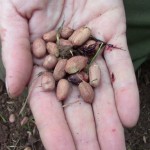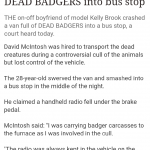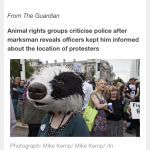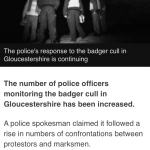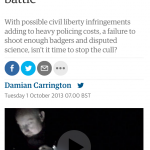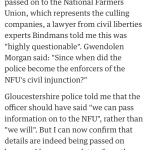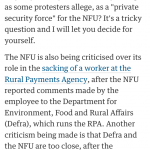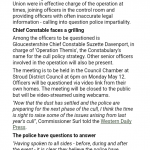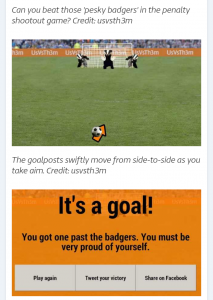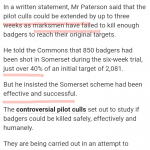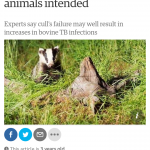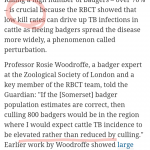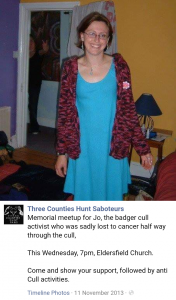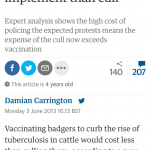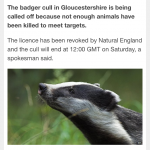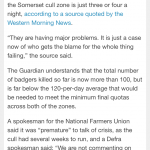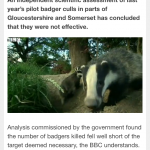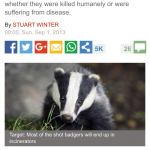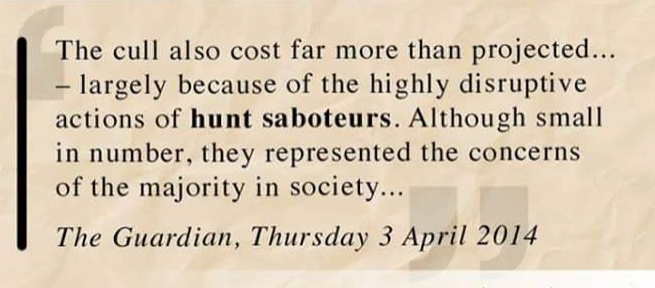The cull had been set to start in 2012 in Gloucestershire and a number of people including sab groups and locals had already begun surveying for badger setts and holding meetings to discuss how to tackle the upcoming massacre. It didn’t go ahead that year after all, which gave us a bit more of a head start and, by the summer of 2013, the area we were calling ‘the cull zone’ had been surveyed as well as possible. At that time, there were three sab groups planning actions within what is now known as the West Gloucestershire Zone, officially Gloucestershire zone 1. Those groups were Nottingham Hunt Sabs, West Midlands Hunt Sabs and Three Counties Hunt Sabs. Between them and other individuals the zone had been surveyed as well as they could and had been split into three areas, Nottingham and West Midlands taking on areas that they believed they would be able to cover on their own.
Three Counties Sabs had agreed to be the group who would liaise with locals and others coming in from outside of the area and so the area taken on by the group (who were the driving force behind setting up Gloucestershire Badger Office, working with other locals and organisations) was larger, two thirds of the entire cull zone.
 Numerous groups, some which were already established, such as IFAW and the Hunt Saboteurs Association, also spoke up against the culls. New groups were also formed and new coalitions – CBAG (Coalition of Badger Action Groups) morphed into Stop The Cull and organisations, like the Badger Trust, banded together under umbrella names such as ‘Team Badger’. Gloucestershire Against Badger Shooting* was set up in order to lobby against the cull and provide a way for people to get involved in trying to stop the cull by lawful means out in the fields – ‘Wounded Badger Patrols’ were organised as structured walks on footpaths within the cull zones, looking out for badgers left wounded by marksmen (and, as a side effect, being a presence in the zone which would put shooters off being able to shoot in areas).
Numerous groups, some which were already established, such as IFAW and the Hunt Saboteurs Association, also spoke up against the culls. New groups were also formed and new coalitions – CBAG (Coalition of Badger Action Groups) morphed into Stop The Cull and organisations, like the Badger Trust, banded together under umbrella names such as ‘Team Badger’. Gloucestershire Against Badger Shooting* was set up in order to lobby against the cull and provide a way for people to get involved in trying to stop the cull by lawful means out in the fields – ‘Wounded Badger Patrols’ were organised as structured walks on footpaths within the cull zones, looking out for badgers left wounded by marksmen (and, as a side effect, being a presence in the zone which would put shooters off being able to shoot in areas).
*GABS was set up around the same time as we began our preparations, some of us at its first meetings, but we are separate groups working in different ways. While we communicate on important issues like updates on cull policy, ensuring each group knows about current legal challenges, new setts, and new threats out in the fields (violent shooters to be aware of, aggressive locals driving dangerously, fields with mother cows with calves, even overgrown paths!) neither group has control of the other. GABS runs structured walks with hi-vis jackets, torches and written policies to sign, staying fully within the law to protect the tactic and patrollers. You do not have to break the law to join us at the Badger Office, we’re just less structured: you can sett-sit, walk footpaths, patrol areas of setts, take responsibility for specific areas throughout the cull or just for a night and use whatever tactics you want (as long as you don’t hurt anyone).
 In Gloucestershire it would be Three Counties Hunt Sabs which would run a public phone number and keep an overview of the cull zone, setts checked and areas being watched over – what they were doing was quickly nicknamed ‘the badger office’ which ended up sticking and becoming official. While some people in the zone would break the law, others would stick to paths or sett-sit (monitor), some trespassing, others not. It was less restricted than the patrols run by GABS, though both ‘structures’ were needed to accommodate a wider range of people. More on all that later…
In Gloucestershire it would be Three Counties Hunt Sabs which would run a public phone number and keep an overview of the cull zone, setts checked and areas being watched over – what they were doing was quickly nicknamed ‘the badger office’ which ended up sticking and becoming official. While some people in the zone would break the law, others would stick to paths or sett-sit (monitor), some trespassing, others not. It was less restricted than the patrols run by GABS, though both ‘structures’ were needed to accommodate a wider range of people. More on all that later…
Legal challenges were going through court behind the scenes as well, including one regarding the length of the cull period. During the ‘Krebs trials’ culling took place in areas for 8 – 11 days to minimise disturbance (obviously other than being killed… the longer setts are disturbed for, the higher the risk of perturbation – badgers moving out of setts, foraging in wider areas and coming into contact with other badger social groups). The legal challenges failed, but they brought up important questions and raised awareness of the flaws of the proposed culls.
“Smash the cull, smash the BNP”
A march had been planned in London at the start of June, organised months in advance with a planned-out route authorised by the police and speeches by representatives of different organisations. Just a couple of days before it was due to go ahead, the BNP, along with the EDL and others, decided to protest in London after the killing of soldier Lee Rigby. We were told by the police that our route had been altered because of this and we would no longer be going past Parliament.
Well…
1. We were adamant that we would be outside Parliament at some point during the demo and…
2. Most of us disagree with many of the views and actions of the BNP, EDL and other right-wing groups* and therefore wanted our voices heard in a counter-protest to them as well (plus we wouldn’t be pushed aside because they had decided last-minute that they wanted to protest on the same day). As our official route came to an end, most of us at the march moved on to join the antifascist counter-demo… and into the news.
*while we certainly don’t agree with what happened to Lee Rigby or support acts of terror, we also disagree with Islamophobia and the making of generalisations against broad categories of people and the furthering of right-wing campaigns by the hi-jacking of tragic events such as this murder
And then we headed back into the fields and woods of Gloucestershire… and found the other side busy with their preparations just like us! As well as looking for setts (important so that we would know where we were needed during the cull) it was also important to be out during the summer to look for signs of preparation by the contractors and landowners – the licence allowed the cull to begin as early as the start of June and it was highly unlikely that we would be informed of the actual start date!
In the weeks before the cull began in September of 2013 (about a week after the Somerset cull kicked off) we put up a couple of public phone numbers and there were various people doing daily checks of a large number of setts.
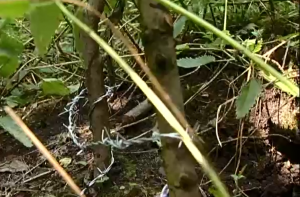 Hair-traps’ were found at different setts (barbed wire strung across badger runs and near seats to collect hair from badgers brushing past) which alerted us to various setts that were definitely going to be targeted by cull contractors, as well as telling us that the cull was due to happen (word had been leaked just a few days prior to this that a cull in Dorset would in fact go ahead instead of Gloucestershire – finding these hair-traps gave us an inkling that the info leaked was fake, though people were also out in Dorset just in case).
Hair-traps’ were found at different setts (barbed wire strung across badger runs and near seats to collect hair from badgers brushing past) which alerted us to various setts that were definitely going to be targeted by cull contractors, as well as telling us that the cull was due to happen (word had been leaked just a few days prior to this that a cull in Dorset would in fact go ahead instead of Gloucestershire – finding these hair-traps gave us an inkling that the info leaked was fake, though people were also out in Dorset just in case).
In one area of Gloucestershire some people were spotted out ‘rambling’ (or so they were dressed) having just got out of a Highways Maintenance vehicle (which had driven into a field)… thinking that perhaps they may have overdone it by mixing 2 different cover identities, a sab contacted a friend in the Somerset zone who said she had just been followed by a guy in a Highways Maintenance vehicle who had then reported her to the police. Cover blown. AHVLA were out checking on setts which would be targeted.
Next we were to find clusters of peanuts left in holes dug into the earth (sometimes deep pits, sometimes a small piece of turf lifted by a spade, sometimes a small hole made with a dibber – another alert as to areas which would be targeted and another step towards the cull beginning. The media were getting more and more interested in what was going on, wanting to film the hair-traps and talk to campaigners.
Hair-trapping Methodologies (PDF)
“I remember finding a lot of holes filled with peanuts in one area – in another it looked like they had literally spread sacks of peanuts all over a ploughed field! – and I put my hand into one of the holes and it was actually a latrine!”
In the final few days before the killing began we finalised areas to be looked after by different groups of people – 3 hunt saboteur groups were taking charge of an area of the cull zone each, with Three Counties Sabs taking a larger piece as they would be working with other groups and individuals who were not part of a sab group. Phone numbers were confirmed, the evening meeting point at Eldersfield Church went live so that people could turn up and meet others and get information on an area of setts that they could keep an eye on through the night.
The so-called science behind the cull stated that to be effective the contractors would have to ‘remove’ (read: kill) 70% of the badger population in the area within a specific time frame. Any longer than about 6 weeks and the risk of spreading the disease further through perturbation (disturbed badgers moving to new areas, foraging and wandering in larger areas, potentially moving on to new land and coming into contact with other badger social groups) would increase.
So… it’s around 2900 badgers to be culled in Gloucestershire in 6 weeks. Keep this in mind!
The police began “Operation Themis” in order to police the cull (stating that they would be impartial). We decided to look up ‘Themis’ as police operations often have amazing names which try to relate to what they’re doing (or just sound epic) and we found… Themis: an ancient Greek Titaness, described as ‘of good counsel’ and the embodiment of divine order, law and custom. Themis means ‘divine law’ rather than human obedience. A gift of the gods, a mark of civilised existence, sometimes it means right custom, proper procedure, social order and sometimes merely ‘the will of the gods’.
The first year was a massive learning curve for all campaigners, not least Three Counties Sabs who state that they ‘winged it using educational guesses’ through parts of the cull. Phone calls were almost non-stop at times with various people calling in tip-offs, registration numbers of vehicles involved in shooting, wanting legal advice or who just wanted to have a rant about how much they hated us / that we were soap-dodgers or on the dole / that we were anti-cow. We also had some good discussions with pro-cull people on occasion.
Someone from 3C Sabs (who would later become part of the GBO collective) was arrested for ‘aggravated trespass’ early in the 2nd week of the cull and, with bail conditions that kept her out of the cull zone, took on running the phone lines, giving ‘phone sab’ the chance to get some in-the-field experience. Only to be arrested just days later, again for ‘aggravated trespass’ elsewhere. She argued her bail conditions strongly as they prevented the use of 3 main motorways and shopping in 3 major towns and they were relaxed somewhat (they only came into play at night, leaving her free during the day) giving her the chance of doing daytime sett checks then returning home to help run the phones at night. The media loved the fact that one woman had been arrested whilst over from the US and a headline read: “I flew 5000 miles to save your badgers” which made her cringe as it’s not how she thought! Both cases were dropped due to lack of evidence just days later, but the daytime sett-checks had already become a new tactic and would soon stretch police resources (as well as giving those who were not able to look after setts at night a way to get involved). It proved a very effective tactic.
“Are you going to confiscate my eyes as well?”
2013 was certainly a year when the police were much more heavy-handed, even being grilled about it on a podcast by Martin Surl at the end of the year… The buzz-word of the cull appeared to be “insurance” with ‘random stops’ being conducted on anti-cull campaigners’ vehicles, sometimes several times a night. During one ‘stop and search’ a pair of night-vision goggles were confiscated on the basis that ‘they could be used to see cages’. 3C’s resident legal “advisor” was being asked by liaison officers from the police why campaigners didn’t trust them when she got the news… they were returned less than an hour later.
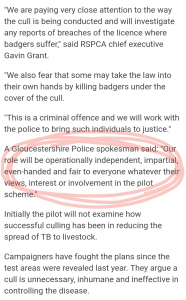 Personal attack alarms (‘rape alarms’) were confiscated from us in the first few weeks of the cull because we could use them to make noise to scare badgers away from shooters. Luckily it didn’t take long for police to realise that publicity wouldn’t be great if it got out that they had confiscated them from lone women walking in the countryside in the dark… unfortunately, before some were returned, two women in an area (who had previously had theirs confiscated) were blocked in on a small road by pro-cullers in 4x4s. When they called 999, worried about what might happen, they refused to send officers out, asking instead what the women were doing at the location in the middle of the night. We responded ourselves…
Personal attack alarms (‘rape alarms’) were confiscated from us in the first few weeks of the cull because we could use them to make noise to scare badgers away from shooters. Luckily it didn’t take long for police to realise that publicity wouldn’t be great if it got out that they had confiscated them from lone women walking in the countryside in the dark… unfortunately, before some were returned, two women in an area (who had previously had theirs confiscated) were blocked in on a small road by pro-cullers in 4x4s. When they called 999, worried about what might happen, they refused to send officers out, asking instead what the women were doing at the location in the middle of the night. We responded ourselves…
During another stop, campaigners were told that their details were going to be passed on to the NFU! And, while searching for items to commit criminal damage (you know, like bolt-cutters) one person’s wallet was searched… When asked what they could possibly be looking for, an officer blurted out that they could be concealing razor blades (for criminal damage?? To cut a cage open with a razor blade would require much dedication – the police obviously thought very highly of us and our determination!)
“Now, I don’t want you to feel harassed, but…”
Without going into a lot of detail for legal reasons, police ended up basically working on behalf of the NFU when they started to go around talking to campaigners about a court order (a civil matter, not a criminal one, and therefore nothing to do with the police). Conditions written into such orders only apply to a person when they’ve professionally been served with them, they are not ‘the law’.
They also read out various notices, the basics of which were that suspected cull activists would be followed by police until they left the cull zone so that they could be ‘monitored’. Any of our vehicles which were being seen around a lot had been given numbers so that they could easily be referred to in police communications and logs. One sab from Three Counties had just been informed that she was to be followed so she took officers for a nice walk… such a shame that the local farmer had sprayed slurry all over a field with a footpath running across it (and into s nearby stream) just a few hours earlier. Her wellies were much easier to wash down than the non-waterproof, heavy boots the officers had had to wear.
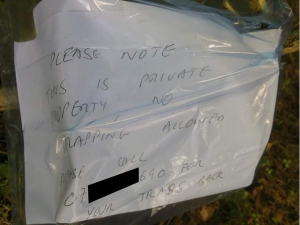 Despite claiming to have always been impartial, police also ‘protected’ cages situated by a footpath near Eldersfield on several nights in a row. Anti-cull landowners were finding bait placed around their boundaries in order to draw out badgers on to land signed up to the cull – so contractors could have been encouraging badgers on to land they wouldn’t otherwise go on to, potential making them come into contact with bTB. Cages were even found on land not signed up!
Despite claiming to have always been impartial, police also ‘protected’ cages situated by a footpath near Eldersfield on several nights in a row. Anti-cull landowners were finding bait placed around their boundaries in order to draw out badgers on to land signed up to the cull – so contractors could have been encouraging badgers on to land they wouldn’t otherwise go on to, potential making them come into contact with bTB. Cages were even found on land not signed up!
In addition to the other examples of police ‘impartiality’, during a couple of serious incidents when cull contractors had left firearms and ammunition in unsafe places and police were called, campaigners found themselves being arrested due to allegations of trespass while contractors were only told off… one 13-year-old girl was arrested whilst being surrounded by armed men in balaclavas.
We weren’t the only ones arrested though, despite the disproportionate and reactionary policing, and cull contractors also found themselves in trouble on occasion – one after telling police that “next time I’ll run them over”, referring to some sabs who had prevented him driving into a field. This year, unfortunately, no distinction was made between arrests of anti-cull campaigners and pro-cullers / contractors and the media often just reported vague details such as ‘a man has been arrested after a violent confrontation’ without specifying that the person arrested was pro-cull. In future years, we would ensure that the police were keeping a more detailed database and that they were making more of a distinction when speaking to the press.
Ledbury huntmaster, Roger Warner, was part of a group who attacked patrollers one night and damaged a car. While victim statements were being given ‘evidence gatherer’ police officers arrived to take the opportunity to film patrollers and gather intel on them, leaving the attackers alone. After repeatedly being asked if they always aggressively filmed the victims of crime who had called them for help, they finally retreated.
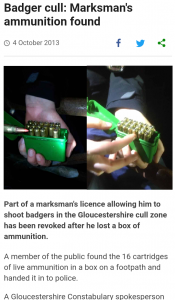 The police did respond fairly well during ‘bulletgate’ when a case full of live ammunition was found by a gate just south of the Forthampton Estate. While there is no specific illegal offence committed, it’s certainly not best practice to leave live ammo lying around and we were told that he was “spoken to”. On some occasions, when police were satisfied that patrollers were indeed on footpaths, they did tell shooters nearby to stop their activities for safety reasons.
The police did respond fairly well during ‘bulletgate’ when a case full of live ammunition was found by a gate just south of the Forthampton Estate. While there is no specific illegal offence committed, it’s certainly not best practice to leave live ammo lying around and we were told that he was “spoken to”. On some occasions, when police were satisfied that patrollers were indeed on footpaths, they did tell shooters nearby to stop their activities for safety reasons.
Quite a few issues were attributed to the fact that police had been drawn in from around the UK. The London-based Metropolitan Police seemed to be the most amusing, as well as heavy-handed, as the nights are much darker out here than in light-polluted London, many did not have warm-enough clothes, waterproofs, torches or satnavs that worked. We also met Scottish police and a unit from Wiltshire who tended to dress in dark coveralls, baseball bats and proper boots and who we first met as a couple of officers drifted silently out of some bushes next to us one night…
Additionally, ex-Gladiator (from the TV series, not the Romans) David McIntosh was taken to court after crashing a van full of dead badgers into a bus stop and blamed a radio he’d been given to keep up-to-date as to protesters’ whereabouts for blocking the brake… Shooters were given police escorts, while driving in full-faced balaclavas, on numerous occasions throughout the entire cull period. Police ignored the fact that many shooters would turn their full-beam headlights (or even fog-lights) on when they saw other vehicles on the road so that their number plates were impossible to see. Of course this also meant that it was impossible for those other drivers to see anything else as they were being blinded… but which vehicles were the ones stopped? Needless to say, it wasn’t the shooters. ‘PIN’s were given out (Public Information Notices regarding suspected harassment) to suspected activists if they were reported to be following shooters (this included a local person driving home after a long shift at work who stated that they were ‘on the fence’ about the cull when they called to let us know).
The police even ended up confirming much of this themselves when complaints were made, including one by an activist about police behaviour one night during the cull – see the response below. In the document, it was confirmed that representatives from the NFU / cull company were present in the operations centre… definitely impartial policing! After the cull finished various complaints were made about the policing, probably from all interested parties in the cull. PCC Martin Surl also questioned police about the choices they made.
Our favourite bits include the fact that there were “two representatives from the contractors present along with one person from the NFU” in the control room. Additionally, “… he was aware that the contractors would advise the communications despatcher… in his opinion this felt as if the Contractor and/or NFY representatives were actually directing the police”.
We’re also concerned about the long shifts without breaks that many police officers had and for the amount of responsibilities laid upon individuals… how can someone be expected to do their jobs properly, especially regarding safety, over a long period of time in conditions like this?
We played on stereotypes to an extent, with anti-cull activists driving 4x4s managing to get themselves waved through police blocking roads and stopping cars – sometimes without having to say anything, other times by shouting angrily about having a job to do! It wasn’t always possible to sneak into areas though and, on several different occasions (looking back at our logs) over the weeks, police blocked off footpaths while shooters were in the area – in early October a sab from the West Midlands group was arrested as she tried to walk along a footpath and a badger was shot as she was detained (in the same area, some shooters pretended to be a wounded badger patrol but their cover was seen through soon after and, on another occasion, sabs were removed by police from a well-signposted footpath under the Trade Union Act!). In other areas officers stalled activists by stopping them on footpaths until they could confirm that it was not private land. On another occasion the extreme opposite… shooters were in a stand-off with a group of sabs and some nearby patrollers and a large group of officers decided to just leave them to it…
GABS (Gloucestershire Against Badger Shooting, who ran the Wounded Badger Patrols) were already liaising with the police – a lot easier for an organisation leading structured patrols and sticking to public rights of way – but police were uneasy about speaking with sabs who had been arrested during the cull… Luckily we had someone on board with the knowledge and clean record needed and he became our police liaison (later going on to start Outpaced). On Halloween, our police liaison attended a meeting and was reassured that police would restrict stops & searches to “lawful ones only” within 24 hours! On two separate occasions in the run up to this, it had been deemed “suspicious” that an sab did not want to listen to officers read out a notice (which was used as grounds to search them) and, having given his details to police and been cooperative, a car driver wound his window up so that he did not have to listen to the same notice being read out. Apparently this was deemed “rude”… and was again used as grounds to search.
Support was incredible throughout the cull and family members and friends of campaigners helped out by doing arrestee support, putting people up and fundraising. Three Counties Sabs spent around £9500 during that first year by giving people money to help with fuel costs, paying for the phone lines and for toilets and a shower at camp. A huge amount of information was called in anonymously by locals who did not want to be known as anti-cull in their communities and we also got calls from local people to ask why they were being followed by police and what should they do about it!
Bad Science
It was obvious that the cull contractors were not killing as many badgers as they were tasked to kill and that the cull would struggle to successfully hit target. In a move that would precede future tactics (of setting low and easier-to-reach targets) Owen Paterson reduced the target figures drastically for both Somerset and Gloucestershire, stating that there were actually far fewer badgers in the areas than previously thought. When asked why he was moving the goalposts at this time, he said that the unpredictable badgers had actually been the ones to move them… which, in a difficult time for wildlife and campaigners alike, at least raised a few smiles. And sparked various satirical articles (and a new game!) A number of points were raised about the fact that the original target figure (of just under 3000 badgers) was now being dropped to 1650…
Info re: population estimates from the CSA (PDF)
1. Was it actually because they realised there was no way they were going to be able to claim that the cull was a success otherwise – remember that it was deemed extremely important to kill at least 70% of badgers in a specific time frame ‘Realistic Analysis’ re: kill figures – rel. to extension (PDF)
2. How did they estimate the population so differently less than a year before? How can so many badgers be killed or leave the area in the space of the winter months? They decided there was “a 92% chance that there were fewer badgers per sett” in 2013. But they couldn’t pinpoint the reasons.
3. If they hadn’t ‘realised’ that their original figure was too high and they had attempted to kill around 2900, they would have wiped out the entire badger population in the area… the task was to cull 70% of the population… 2900 was 70% of the original population estimate. 1650 is 70% of the revised estimate (well, no, even DEFRA says it needed to be a minimum of 1920 but they went for 1650 – why?). Meaning that they would have all been wiped out if contractors had carried on…
They reckoned that they wouldn’t have wiped out the entire population because they were only culling on 70% of the land within the cull boundaries. Do they really think that badgers stay within legal boundaries of land owned by humans? That they don’t travel from anti-cull to pro-cull land at all? Did they really believe that some contractors wouldn’t be sneaky and try to hide cages on land not signed up?
Paterson claimed that the badger population had dropped since the original estimate was made in October 2012, that using hair-traps, etc in summer 2013 was much more accurate. But the cull began before the revised estimate had even been confirmed! To be fair, even if it had been confirmed it’s hardly the greatest bit of research conducted: “the 2013 estimate of the badger population in Gloucestershire was from 1520 to 3460 with a central estimate of 2350… translates to an objective of 1920 badgers killed to achieve an 80% chance of culling 70%“. Sounds scientific… on top of this, the cull hadn’t gone ahead as planned in 2012 as the population was deemed too high for a realistic chance of reaching the 70% target. Meanwhile Paterson was spewing out bTB figures which had “been exaggerated” due to an “IT glitch”.
Confused yet?
The 6 week cull period came to a close. Somerset had started, and finished, a week before us so we got word in advance that an extension may be applied for if the kill target had not been reached (but would be within reach if an extension were to be granted). Licence extension application (PDF)
The figure was released… 708 badgers killed in 6 weeks. That’s about 30%.
Somerset were granted a 3-week extension and those campaigners who had come to help us out in Gloucestershire headed south once more. We prepared ourselves for similar but heard that the cull company might ask for an additional 6 weeks (!) as the kill target was larger than the target in Somerset. The huntsman of the Cotswold Vale Farmers’ Hunt at the time let it slip to 3C Sabs that 8 weeks had been applied for, with sabs wondering if such an extension might be granted to assignments due at uni… surely you can’t extend a 6-week period by a further 8 weeks?! But they did. Uni didn’t…
DEFRA / Natural England extension letter (PDF)
The police stated that they were not in a position to physical police the cull that night (23rd October) but would instead run “Community Reassurance Patrols”. They began by sending a large group of officers to our evening meeting point to ‘reassure’ everyone there that their cars were not stolen and that all of their documents were in order. For over 40 minutes.
Around the same time, suspicions were confirmed that the cull zone extended further than the River Severn and the boundary was more likely to be the M5. This was backed up by the news that contractors had been more successful in the very east and west parts of the zone than in the central areas. The new ‘Far East’ area was surveyed within a couple of days and a few people took on responsibility for keeping tabs on the setts there and ensuring they were checked and protected as best they could.
By now we knew what we were doing, evening and daytime meeting points were established and working efficiently and we were information-gathering and sharing effectively. With more people feeling confident and knowing areas well, more ‘autonomous groups’ set up around the area – these were areas that we could then leave in the hands of these capable people, individuals and groups, who would keep tabs on an area and deal with issues themselves, calling us for back-up and to keep us up-to-date with any developments, especially any that would affect other areas. This lessened the work we had to do, making us more of a switchboard, keeping a general overview of the zone and keeping everyone up-to-date with developments, new ideas for tactics and call-outs for back-up.
Wounded Badger Patrollers were doing a fantastic job themselves, some coming out in the day to look for injured animals and not being deterred by various incidents they had had to deal with (slashed tyres, superglued locks, one guy even punched the bonnet of a car patrollers had just got into and the then-huntsman of the Ross Harriers kept harassing patrollers at their meeting points). They began to do more patrols, covering more ground, with fewer people in each.
“You’re illegally walking without a footpath!”
We dealt with numerous incidents, including incidents of wildlife crime – such as the blocking of a sett by landowner Ken Arrowsmith in Redmarley. When the sett was unblocked, he had it re-blocked and the earth packed down hard using machinery. Apparently he wanted to build holiday homes, the badgers scare the children and poo on the lawn sometimes… Accusing us of having ‘carrier bags of green stuff’ (cat and dog repellent which was being tested to see if it would stop badgers from going near to bait points) he got the police involved himself, trying to convince them that footpaths are only ‘valid’ until 10pm. Later that night we dropped off a ‘carrier bag of clean stuff’ for a nearby sab staying in her car. Soon after he said the pressure from both sides was too much and decided that renters of holiday homes in fact love to watch badgers play. His land is still being checked just in case…
In the same area, we had heard rumours that local pro-cull landowners were up at all hours doing their own patrols. To try to find us. A couple of people from the office collective were in fits of giggles one night as they were surrounded by at least 3 locals, closing in on them and using whistles to communicate with one another. Listening to the whistles, the sabs kept tabs on their location and managed to escape through a brambly hedge before going about their business! In the same area, a patroller who walks with two sticks was driven into (on purpose) by a local landowner.
We also had some fun with ‘Mullet Man’, a guy spotted out in the Redmarley area of the zone checking on pre-bait in the evening hours. He wasn’t too happy about being known, even aggressively driving at sett-sitters on occasion, but calmed down over the months and was happier in future years to talk to campaigners (shame the same couldn’t be said for more pro-cull people!)
We found out the sad news that a good friend and fellow animal activist, Jo, finally lost her battle with cancer during the cull, aged 36. Knowing that she would want us out in the fields, we held a short memorial event at our evening meeting point in Eldersfield on the day of her funeral. Jo had been involved in various campaigns against animal abuse, including helping to found Stop The Cull, and will be missed by many!
After almost another 6 weeks the extension was cancelled early as the cull contractors had no chance of reaching the minimum target. 921 lives were lost in total (708 in the original 6 weeks and 213 in the extended period) but GlosCon had fallen far short of the original target of around 2900 (and even the revised figure someway through of around 1650 after ‘the badgers had moved the goalposts’). The cost, per badger, of conducting the cull was estimated to be around £7000. Shocking, but it had been predicted before the cull even started that badger vaccination would be far cheaper. Brian May (and many others) argued that the only reason the number of badgers killed was 921 was because of the much higher use of cage traps than expected – the pilot culls were supposed to be testing the effectiveness of shooting free-running badgers… if you’re caging and shooting, you can cage and vaccinate, it was argued.
So it’s now been around 13 weeks (including the week-long ‘limbo’ period between the cull and extension) and nowhere near the target number has reached. What did the science say again??
“Safely, Humanely, Effectively”
The IEP (Independent Expert Panel) was in place in the first year of the cull and was looking at whether badger culling could take place safely, humanely and effectively. They produced a report which was published early in 2014 and which highlighted cases where badgers took several minutes to die, along with various recommendations for improving in the future.
Natural England weren’t entirely happy with the report, hypocritically saying that the IEP had relied solely on anecdotal evidence in some cases (which Natural England, the NFU and DEFRA would go on to do so on a much larger scale when it came to talking about ‘reductions’ in bTB). While they took some recommendations on board, they argued that the cull had actually been safe, effective and humane and then did away with the IEP for the future years of the cull…
Many other animals were helped during the cull, a huge number treated by Vale Wildlife Hospital.
We weren’t perfect by any stretch of the imagination and made hundreds of mistakes, some stupid ones, others just due to lack of experience of having to make a choice between 2 or more difficult options. Bonds were formed, some were broken, but many of us learned what skills we could contribute and where they were most needed. People joined GABS’ wounded badger patrols, others joined us, some decided to stay quiet and listen for info in their local communities, some joined us out in the fields, online, on the streets. All in all we were saddened by those who had died but we were confident that we would be a much more formidable force to reckon with… against wildlife persecution, legal and illegal, in general. While this quote mentions hunt sabs specifically, everyone doing their bit was a cull saboteur and contributed to saving lives! We had people out of all ages, all fitness levels and abilities, whether they were on call 24/7 or out for an hour a week.
On that note, we’ll end with a personal story from someone who ended up contributing more than they planned and having more adventures than expected. It’s not the young’uns that get stuck in!
“My friend and I became quite involved in sett surveying and monitoring in early 2013; we had already attended various public meetings and demos prior to this. She lived in the Glos Cull zone. We were unsure of what to expect when the cull started but, having been on tenterhooks all through the summer, it all began. We did a variety of roles from patrolling and sett-sitting to gathering Intel. Some nights we were in a car trying to monitor several setts at once and on one occasion we were “first responders” to a call and spent half an hour facing off two shooters on quad bikes. Not something I ever envisaged doing!
We learnt a great deal about badgers, ourselves and others. We got used to checking the car before every trip: tyres, brake lights, etc. I cannot recall how many times the police stopped us but I know the record was 5 times in one night! Most of the time they were polite and courteous but we knew that they were there to enable the shooters to do their job and we were an inconvenience. My view of the police has changed forever now. They really did feel like the NFU private security force.
On one occasion a farmer banged on our car windows and threw things at the car; he also had a large dog with him which he dragged round to the side of my car. He was abusive and aggressive and I told him we would call the police – we did a 999 call which was responded to with contempt by the call centre. The farmer called someone on his phone and a police van arrived. I asked if it was in response to our call and they looked bemused… No. It was in response to the farmer’s call, he clearly had a hotline to them which two lone women in their 60s did not, another lesson learned!
Yes, being involved can be upsetting at times and it can make you feel angry and sometimes helpless but when you go home in the morning knowing that you have helped save some badgers it makes it worth it; you are part of a great team of people who have all come together to help save what is normally a protected species and you know you will be out again every night that you can be”.
We were very happy to have a journalist working for Reel News out with us for many nights (and days) and who wrote a brilliant article to go along with a video made of the campaign…












